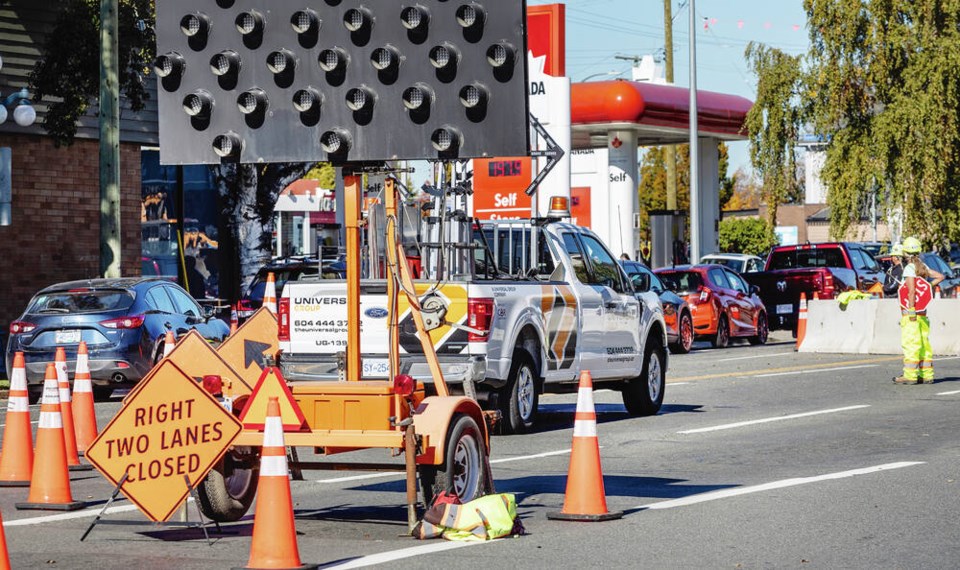Is it just me or does there seem to be more highway confusion out there these days? By that I mean engineering and placement of all those signs, lines, cones, signals and markers that not only don’t make any sense, but actually create traffic problems instead of solving them.
One of my favourites, and by favourite I mean really annoying, is the mandatory turn lane which, based on the way it is marked, is actually illegal to move into. They’re quite common.
A lane at an intersection is marked with a white left or right turn arrow on the pavement. But that lane is then delineated by a white line which extends back to a point where cars might be parked or a bike lane exists. Because of that solid white line, it’s illegal to cross into. How hard is it to paint a white line sufficiently short enough to allow traffic to legally move into the proper lane?
Another peeve is the conflicting playground zone. At one point there is a yellow and black sign showing a stick figure running with a ball, with another small tab below it reading 30 km/h. Fair enough — it’s a playground. But a few metres later there’s another identical playground sign, this time without the required speed tab — making it a warning sign only. Which one do you believe? Good drivers will obviously apply common sense, but signs placed like this still create needless confusion. If it’s 30k, then say so.
Next up is the phantom construction zone — you know, the ones where all the orange construction signs are still up blocking lanes or reducing speed, with no construction crews or equipment anywhere in sight. Often you find these objects still stuck along the road long after the actual construction has obviously been finished. This is why many drivers get nabbed later on in other construction zones because they, with some merit, believe there’s nothing really going construction-wise — until there is.
The cousin of the phantom construction zone is the phantom street itself. The poor thing has no name. At an intersection, the cross street gets a name with a sign, but the street you’re driving on remains a nameless orphan. Of course if you’ve lived in the neighbourhood for 50 years, then you obviously know the name of that street — everyone round here does. Well, I don’t. I’ve never driven round there before and I’d like the all the signs at intersections to let me know where the heck I am.
The on-again-off-again bike lane also makes the pet peeve list. They’re the ones where there is a bike lane marker in the roadway that suddenly ends without any notice, but the white-lined shoulder lane never changes. Then the bike lane markers reappear a little further along, this time with all the trappings, such as green-painted warning patches and “Yield to Cyclists” signs — all on the same strip of shoulder that has been there for kilometres. Is it a bike lane or not? In the same vein, why do some driveways on bike lanes warrant a green warning patch while others do not? Hopefully it’s not just about the green paint budget.
Another goody is the mismatched centre line. This happens when curbs at intersections are widened in an effort to create traffic calming. The space for travel is reduced, requiring the centre line to be moved to fit vehicles passing through. Except now the centre line near the intersection doesn’t match the centre line running through the rest of the block. As you pull up to the intersection suddenly you’re halfway over into the oncoming traffic lane. Apparently the painting machine capable of making a slight curve to properly connect two yellow centre lines is in for repair.
Speaking of road lines, why do they dissolve and disappear in the rain at night? I get two emails a week complaining about this. The visibility of road marking in inclement weather is a big deal for many drivers. Why, they ask, have we not found a technology that can keep important road markings clearly visible at all times? It’s a good question. Part of the problem lies in the general condition of many local roads. Part of it lies with the federal government’s ban on using oil-based paint marking since 2010.
Oil-based paint contains volatile organic compounds, or VOCs, which were commonly used because of superior visibility and reflectiveness, especially at night and in bad weather. Road paint now contains low VOC alkyds and water-based formulas, but requires more frequent painting and/or the insertion of glass beads for great reflectiveness.
Road safety versus protecting the environment — I’ll raise the white flag on trying to reconcile that one.



